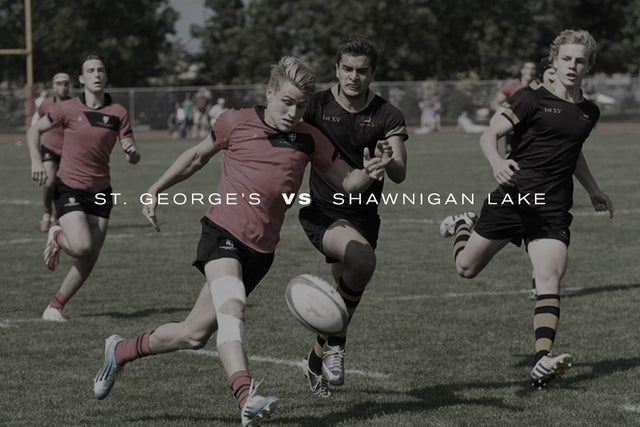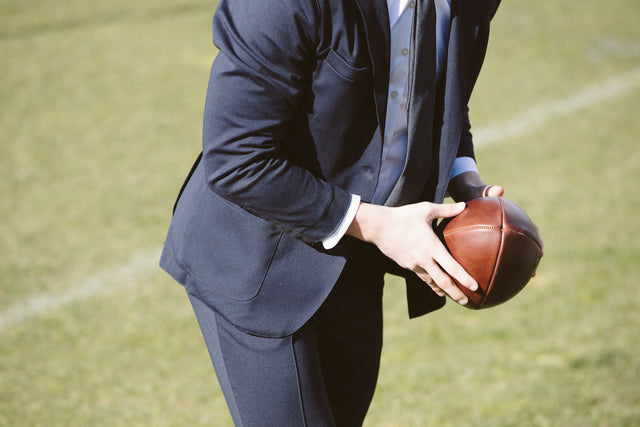St. George’s and Shawnigan Lake - Examining two of BC’s Premier High School Programs
Written By: Adam McQueen
In the Canadian rugby landscape, both Shawnigan Lake School and St. George’s School are synonymous with excellence. Each program has pumped out national team talent, boasting an endless list of former players that have donned the red and white for Canada at the XV’s and 7’s level. In recent years, they have continuously raised the benchmark of success for schools across British Columbia to aspire toward, meeting in six of the past eight provincial championships. Yet, the on-field dominance is merely a by-product of greater goals that both programs share. St. George’s and Shawnigan Lake each use rugby as a vehicle to build character, learn respect, and develop a love for the greatest sport on earth.
However, neither program shies away from their success on the pitch. Although separated by the Georgia Strait, Shawnigan Lake and St. George’s are well aware that their paths will inevitably cross.
“Both teams have a healthy respect for each other,” says Tim Murdy, the Head of Rugby at Shawnigan Lake. “We know at some point we are going to see them, whether it is in the final or semi final.”
While Shawnigan Lake have taken home eight provincial banners in the last decade, many finals against their Vancouver-based rivals have been excruciatingly close encounters. Murdy attests the regularity of this provincial final matchup to the extra preparation provided, as well as the depth of their respective junior programs.
“There are a number of other strong schools. St. George’s and Shawnigan have just been more consistent year in year out in being able to prepare their teams for the provincial tournament,” Murdy notes. “The independent schools are at a little bit of an advantage in that the kids play more rugby. All of them have junior programs that lead into senior programs, and in many cases they also have skills terms available to their students.”
Constantly locking horns in a provincial championship will intensify encounters. However, St. George’s Assistant Coach, Bill Chamberlain, insists that the history is the backbone of their rivalry. The black and gold of Shawnigan are often the first competitive opponents his players face in their rugby careers.
“It is built in tradition. If you look back at our history, the early stories of our history are games against Shawnigan. So we’ve been playing each other for a long time,” Chamberlain explains. “In grades 8, 9, and 10, our guys play against each other, that is our schedule. We don’t play any other local schools, other than ones that want to. It is more traditional than anything.”
While the on field success has driven the competitive rivalry between both programs, it is the installation of a culture off of the pitch and a love for the game that has equally contributed to the development of both powerhouses.
So what is this culture exactly?
“There is a culture of pride more than anything,” Murdy acknowledges. “A real sense of pride in playing for the school, a real sense of pride in maintaining the legacy, doing both the jersey and yourselves proud.”
Representing Shawnigan Lake comes with a slew of benefits, yet the weight of representing a program with such a rich legacy can become strenuous, Murdy admits.
“At times it gets to be a bit of a burden on the kids because they put pressure on themselves. I try to get them to understand that what teams in the past have done is fantastic for them, but that you guys are a different team… your journey is very much your own.”
In contrast, the storied history that St. George’s also possesses serves as an oft-overlooked reminder: the program is larger than any single individual. Saints rugby is a novel, each year is simply another chapter added to the story. All egos must be checked at the door.
“On the back tail of the jersey there is a number of what year
Living and breathing rugby for 85 years becomes infectious for all on campus, no matter the level of experience nor skill. The sport has woven itself into the fabric of St. George’s, its culture playing an integral part in nearly every student who passes through the campus. Chamberlain hopes that this passion for the sport continues to resonate amongst players long after they graduate.
“When spring hits, kids who have never played rugby before will come out because they want to be a part of it,” says Chamberlain. “We have a lot of active alumni playing right now, which is amazing to look at. What we hope is that when our players come to these new programs they are able to play rugby. Kids keep playing so I believe they have had fun here and continue to enjoy the sport!”
For Shawnigan Lake, a boarding school in which 90% of the student population resides on campus, the rugby team are an easy group to distinguish. Their hulking frames and countless visits to the cafeteria are dead giveaways.
“At times rugby can get quite serious around here and the boys get a lot of the limelight. We want them to be proud, but never at the expense of being arrogant,” Murdy says of his players’ stature on campus. “This is a school that prides itself on a well-rounded experience. This includes academics, sport, fine art and community development.”
Training, competing, and winning cannot be the entire focus of each player’s high school experience. Rugby demands a lot from those in both schools, however the values each program instills must permeate into other facets of life.
“We want them to give back in the houses, and around campus, by acting as strong role models for our younger students. Many of them are School or House prefects, taking on leadership roles for this very reason,” Murdy continues. “They get so much from this experience, so we want them to give back.”
Although it has become a near formality that St. George’s and Shawnigan will oppose each other come May, the clichéd approach to ‘take one game at a time’ is a philosophy both programs try to instill.
“I respect the way they play. They are always well-drilled and play an attractive brand of rugby,” says Murdy of St. George’s on field product. “The kids all know each other and keep track and what not, but I try to keep my guys away from that sort of thing. We’ve got enough to worry about with our own game!”
When posed with the same question, Chamberlain chuckles and offers a succinct response.
“There is not much to keep track of, because their results say everything.”
High school programs are a carousel of sorts, as personnel changes from year to year. In order to be successful, coaches must adapt to these circumstances. Shawnigan Lake and St. George’s are blessed with a wealth of talent. However, their teams are a blank canvas when starting each and every season.
“We don’t really know the way we are going to play until the kids are out there,” Murdy of his team’s playing style. “We may have a dominant forward pack, or maybe a fast back three… it changes year to year.”
Chamberlain adopts a similar approach.
“We have to adapt our game-plan to what our strengths are, and if it is good enough at the time then so be it.”
Despite brushing off the idea of a competitive rivalry with Shawnigan due to the fact that on numerous occasions St. Georges has fallen agonizingly short, Chamberlain highlights a key ingredient on the field that has brought success against their counterparts.
“If you look back at the years that we have been competitive, when we had games that could’ve gone either way, the one thing that is consistent is that the only time this happens is when we are physically able to compete.”
For Tommy Kirkham, St. George’s Captain in 2010, his most vivid memories span back to the moments competing against the province’s best. These memories personified what it meant to represent St. George’s.
“My favourite moment of a game was when our inside centre, Angus MacPhail, (who by the way is a natural prop) made a bone-shattering goal line tackle that saved us the tie,” Kirkham says, reflecting upon their 13-13 matchup against Shawnigan in the inaugural N.R.L Toy game. “That stands out as an excellent example of Saints rugby; we didn’t have the players for an ideal backline, but a prop showed promise, so he slotted in, and ended up being one of the best backs we had.”
Despite suffering a heartbreaking loss in the provincial championship that year, Kirkham relished the opportunity to attempt to dethrone the kings of British Columbia high school rugby.
“Every win or loss by either side was a statement. For Shawnigan, it was to prove that they are the best. For us, it was to try and show the province that they weren’t invincible,” says Kirkham. “The only way to try and be as good as they are is to play them, get whooped, then come back in provincials or the next year and be better.”
While there are quiet murmurs of resentment across British Columbia about Shawnigan’s sustained dominance, both Kirkham and Chamberlain squash that notion.
“Around the province people like to say that the quality of rugby has fallen, whereas I believe the quality of rugby people are trying to play is better,” Chamberlain notes. “The stuff we are trying to do with the guys, be it putting layers in our attack, diagnosing defenses, it is all attributable to keeping up with Shawnigan. They have made the bar higher.”
Kirkham echoes these sentiments, emphasizing that there is more to the sport than compiling results on the scoreboard.
“It is a huge shame that there has been a recent history of boycotting matches against Shawnigan. In general, I think many young athletes need to step back and evaluate why they play the sports that they do. It should be fun to head out onto the pitch and compete at every level, whether that is a pickup game of touch or the provincial final against your biggest rival.”
This must be the overarching goal of youth sports. To have fun.
Success on the field will always sweeten the taste. However, the fondest memories that players and coaches from both programs share do not solely revolve around championship banners nor lopsided scores. They stem from the relationships they have created, the battles they have shared, and the legacies that they have added to.


